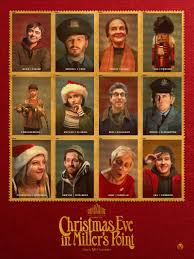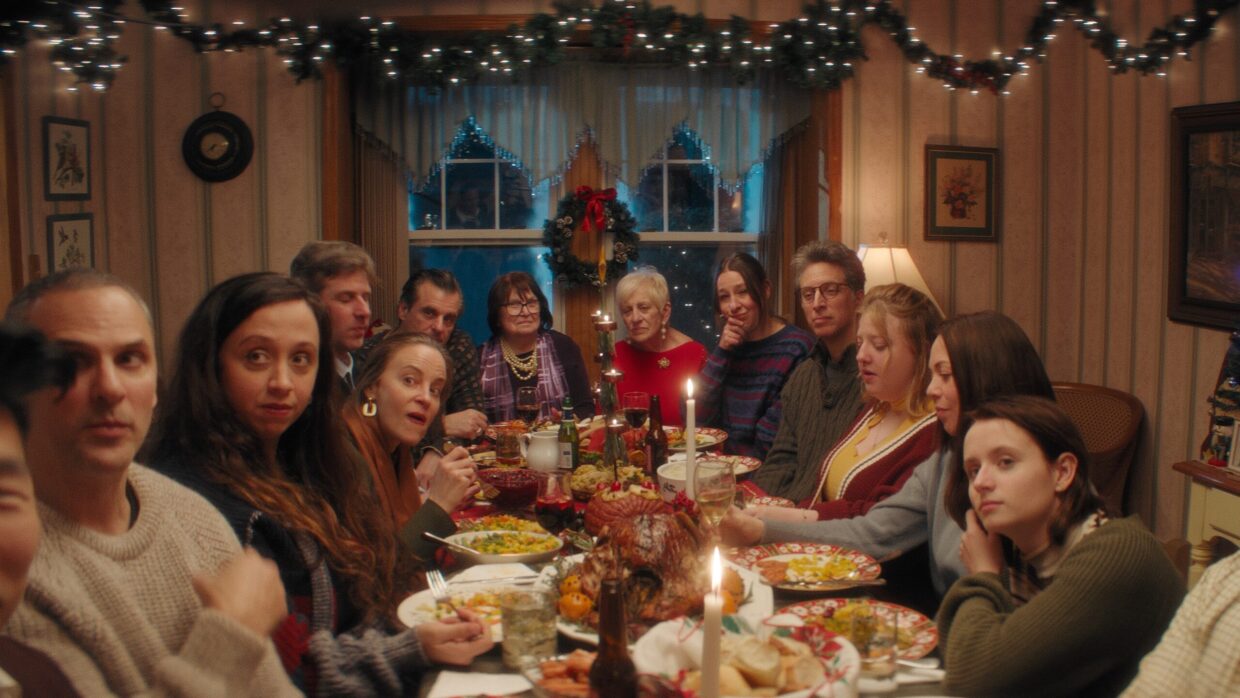The breadth and depth of your own Christmas memories will determine whether Tyler Taormina’s expansive fantasy, Christmas Eve in Miller’s Point, turns out to be a reassuringly contemplative or deeply unsettling examination of American holiday customs. However, Taormina’s wide canvas allows for and incorporates the entire gamut of emotions that the theatre of Christmas can elicit, from the giddy excitement of an overstimulated child to the groaning of an adult realising that family problems have only been temporarily put on hold due to the holiday. This is one of the film’s strongest points. Furthermore, Taormina’s image stands out for producing a type of narrative excess in almost non-narrative ways. The plot of the film is paradoxically both overstuffed—any member of its large cast could have played the lead in a different picture—and sparse, with poignant moments and thought-provoking lines of dialogue swiftly engulfed in its sensual flow of holiday music performed by girl groups, twinkling lights, and, in a surreal scene, a fire truck dressed like Santa’s sled pulling up to the sound of nearby children squealing.
Christmas Eve in Miller’s Point, an impressively larger-scale follow-up to Taormina’s microbudget Ham on Rye, is set in an Italian-American neighbourhood of Long Island, New York. For the first two thirds of the film, the action takes place in a single house, where the adult children are celebrating their last Christmas together before, most likely, selling it and moving their mother into assisted living. The teenage kids, featuring a powerful debut by Matilda Fleming, hide out in the basement, flaunt their pet lizard, and later go out for drinks, hookups, and—in a strikingly romantic moment—nighttime ice skating. Deadpan, Michael Cera, and Greg Turkington portray drowsy police officers who, it turns out, have mixed feelings about Christmas. Actually, though, the movie is a gestalt that blends the director’s own Christmas memories with the festive Americana that television, movies, and ads (particularly Coca-Cola) have ingrained in all of us. This mixture fulfils its promise of providing Christmas cheer while also having a mesmerising uncanny quality that gives those of us who are not fond of the holiday season an aesthetic lifeline.
Before Cannes, I chatted with Omnes Films founder and screenwriter Taormina about his personal holidays, making his film a neighbourhood project, and why he produced Christmas Eve in Miller’s Point purely independently after first attempting an industry approach. Taormina is featured in our 2021 25 New Faces series. (Taormina’s film is one of two Omnes entries in Cannes this year; Carson Lund, who also directed Eephus, his own picture, which debuted in Directors Fortnight, is the director of Christmas.)

Filmmaker: My parents, brother, and I are the only members of a small family. There were no large extended family holidays celebrated with the presence of numerous neighbours. We had quite different Christmases than the one in Christmas Eve in Miller’s Point, so your movie—especially the first part—was really shocking to me. What kind of Christmas did you have? Were they really this large? What childhood experiences did you incorporate into this movie?
Taormina: They did resemble the movie, albeit perhaps more in a “emotional truth way” than a literal one. Indeed, a large family with an immense amount of affection for one another. It doesn’t really matter if none of us truly understood the others. All that mattered was that we supported one another. So many joyful moments. Having seen these people throughout the years, I believe that one of the main reasons this video was made was the realisation of how much time has stolen away. In particular, I discovered that I was unable to watch old home videos. I simply couldn’t bring myself to look at how much time had gone and how things had altered on an emotional level. And I believe that this attempt was made to actually bring that back to life and overcome the overwhelming experience that was time for me.
Filmmaker: Was it challenging to view home videos in general or during this research?
Taormina: Which, in a way, brought this about. My parents’ pre-marriage wedding video served as the beginning of it. I viewed their home video on their 30th anniversary, which was a very pivotal time in my life. It was then that I realised I was a cineaste and that this was what I should pursue with my life. This movie, in my opinion, is largely influenced by that experience, which had me facing my past and the reality that we are all here.
Filmmaker: After seeing the end product, do you think it successfully resurrects these memories, or are you aiming for something that is ultimately beyond of reach?
Taormina: It seems as though the firefly was trapped in the jar, allowing me to simply see it glowing within. I genuinely believe that’s it. I mean, I’m proud of the movie’s richness in terms of layers, detail, and other things. I feel like it’s kind of unavoidable, but there are just so many things I regret not getting. Despite this, I can relate to the movie since it effectively captures the essence of what I held dear and certain basic, fundamental sense memories.
Filmmaker: You brought up detail, which is, in my opinion, a big part of the movie. There are just so many minute nuances in it, especially in the production design. I saw that several families are given credit for the set decoration in the credits.
Taormina: As I mentioned earlier, the details are the driving force of this film. That’s strange because, looking back, I recruited Paris Peterson, a buddy of a friend, to handle the production design. Over the years, I had become somewhat acquainted with him; in fact, Daniel Goldhaber put us in touch. He had never worked on a feature film production design. The only music video I had really seen him production design used cardboard cutouts, kind of like arts and crafts. My understanding of his actual work was so quite limited. However, I had a feeling that he would perform admirably. He’s just a really delicate man. I was aware that the task would be extremely difficult, but there was something about him that completely persuaded me. And I believe that since I had faith in him, he went above and above to make this movie.
A large portion of the film’s décor is an amalgam of the communities’ residents, families, decorators, and producers. In three of the four residences that make up the movie, the mother lived longer than the father did, and the children were going to sell the house. which is the movie’s plot! These were really the only homes that would permit our invasion, you know? We were a massive organisation. For this reason, the movie felt very personal to many individuals, including me.
Filmmaker: During which season did you shoot?
Taormina: March and February.
Filmmaker: So, in essence, these folks were retrieving their Christmas decorations from the attic?
Taormina: Accurate. We wrote a tonne of notes around the neighbourhood asking people if they would mind keeping their Christmas lights up until the middle of March. We’re going to record,” and some individuals actually did. Some even went so far as to remodel their homes especially for our photo shoot.
Filmmaker: Your partner at Omnes Films and your DP for this project, Carson Lund, wrote a piece for us about his experience filming your last film, Ham on Rye, as an L.A. microbudget movie that costs about $20,000 and doesn’t require any permissions. I’m not sure how much the production budget was for this one, but it’s certainly much more. Furthermore, you made notice in interviews of all the speaking roles in that movie, something you’ve really stepped up with an even larger cast for this one. This movie is night; most of Ham on Rye is day. This is East Coast; ham on Rye was West Coast. In light of all these modifications, how did you modify your Omnes Films production model?
Taormina: I believe that no amount of expertise can adequately prepare you for what lies ahead when it comes to scaling up expenses. We discovered this while filming our first two location features, Eephus and Christmas, at approximately the same time. Making a location film brings with it a whole new set of issues that I had no idea could arise. It was difficult to plan the logistics of moving and housing the actors and crew. I believe we spent six months preparing this time. I could take as much time as I needed to cast the movie and gradually gather all these resources because I was living at home in my parents’ Long Island home. In a similar vein, the lengthy soft prep was a cost-saving measure; yet, time is probably more expensive in a more traditional producing paradigm. For many, it was also immersive, even though it was just a tonne of additional headaches. Long Island was home to a large population, but there was also a large influx of individuals from the city, Boston, and Los Angeles. However, we decided without searching for new [crew] members. Instead, we simply invited our friends to help with sound recording and camera work since it comes naturally to us to be around individuals who can make each other laugh and feel stimulated.
Having the house ready to shoot in as much as possible was a big part of our economical approach to making this movie, as we had a tonne of practical lighting living there and doing a lot of the work. In order to facilitate the fastest workflow possible, the production design of the area and the lighting were carefully considered.
Filmmaker: There was never a sense of financial restraint in the movie, and the minute touches, such as the moment where the woman is seated in the tiny vestibule with each windowpane completely iced, never ceased to astound me.
Taormina: Paris Peterson was aware of the frost game; I was unaware of it.
Filmmaker: You’ve discussed the idea of the communal protagonist in previous interviews, and you bring it up again in this one. The movie has a plethora of little, interconnected tales, none of which takes the stage. How did you go about developing your script? Do you have ten thousand coloured index cards hanging on the wall in your office?
Taormina: My pals make jokes about these index cards that follow me around the house. They believe I’m insane. However, Eric Berger, my co-screenwriter, and I essentially went inside log cabins and decorated them for Christmas, which we probably did four or five times. We didn’t write anything throughout the first two sessions. We just drew out the family tree and discussed how each person’s life had impacted the others. How the children were affected by the patriarch’s death was one of the important considerations made. What impact did that have on [the adults’] ability to parent their kids? What impact did that have on their family relationships? It was incredibly engaging and exciting to work on that collective psychology of the family group. You know, we intended this to look like animals. This movie reminds me of an overflowing Petri dish filled with microorganisms. I believe Eric’s mindset is always focused on moderation and keeping things simple enough so you’re connecting with the essence of anything living rather than the facts.
Filmmaker: You mentioned that Ham on Rye was inspired by the films of Robert Altman and John Hughes. Who would be the film’s inspirational directors?
Taormina: Yes, they are also present. This reminds me a lot of Ham on Rye in many respects. But American Graffiti and Diner would be some major influences. Additionally, there were Martin Scorsese films, which were edited but not particularly notable throughout production.
My argument is that these movies and their directors have had such a cultural impact that they are included in this kind of Long Island Italian ethnographic research. They analyse themselves through the lens of Scorsese films. It’s somewhat absurd and hilarious. There were numerous other inspirations as well; among the most significant, as Carson and I discussed, was the Coca-Cola logo and their holiday advertisements. And Sirk, of course.
Filmmaker: Scorsese has a reputation for using songs as musical scores for his films, dating back to Mean Streets and Goodfellas. It is a challenging strategy to implement these days on a low-budget picture, especially given that the movie features many well-known songs. How hard was it to pick up on some of those cues?
Taormina: Well, as you could expect, the soundtrack plays a major role in the development of the film. It is clearly inspired by Scorpio Rising rather than, at least, Martin Scorsese. These songs play such a significant role in [Miller’s Point Christmas Eve]. To start, they’re Christmas music without really sounding like Christmas songs, which is, in my opinion, the only option. Naturally, they also have a nostalgic feel to them. The lyrics, however, are what truly make them so amazing to me. They are all along the lines of “I love you,” “I want to be with you,” and “I can’t be with you anymore.” I love to imagine the phrases “You break my heart” and “You left me” in the context of a mother losing control over her daughter or a cousin who is unable to leave the family. We were fortunate that everyone was so enthusiastic about the movie, which helped us actually clear the songs. Very few songs needed to be changed because of the way we presented it.
Filmmaker: So there was a connection between the scenes’ thematic content and the song’s lyrics? Did you have those tunes on your mind when you were writing, or did you match them later?
Taormina: The scene headings would include the songs, and the script included a Spotify link on the main page.
Filmmaker: Did you use private funding for all of this?
Taormina: That is accurate, indeed.
Filmmaker: Did you attempt to approach it from a more professional standpoint?
Taormina: Did I have to wait around in development for a whole year and a half? Yes. “It will happen, it will happen,” and then a year and a half passes. We had producers on the picture who were slightly more renowned and experienced, and we were packaging the movie with one of the major agencies. Sure, they all gave it a shot. However, I believe that producers give it a little push to see how far it will roll before moving on to the next. I did, therefore, deal with the transient delusion that “this is happening now,” which in a way helped me grow. When I felt like the Hollywood industry was kind of hanging me and my agency over my life was being taken away, it was an extremely difficult time for me. But as a result, this production is really a family affair for you.
Filmmaker: Did you take a break one day and try a different approach, or were you experimenting on the side?
Taormina: I wasn’t experimenting on the side with [another strategy]. My problem was that I was merely putting my trust in it.
Filmmaker: So, at one point you just said, “We’re going to do this another way, but thank you for your efforts”?
Taormina: You’re correct. That is the polite manner of putting it.
Filmmaker: After that, how long did it take you to secure funding?
Taormina: To be honest, it wasn’t long because I was so furious at the moment. I had this notion how to finance it and a model that would be extremely accommodating to the actors and crew, so I was just like, “Screw this Hollywood thing, let’s just do this our own way,” while I was speaking with these friends of friends who were kind of in the private equity world. While everyone received a fair salary, there are differences in the additional payments. We worked up a percentage so that everyone could participate, including the performers who aren’t SAG members. If this film turns into a beloved annual viewing experience and we’re not all enjoying it together, it would hurt my heart, you know?
However, I believe that there would have been less time and resources if we had followed the Hollywood path. I recently learned of a $10 million movie that took 23 or 24 days to shoot.
Filmmaker: What was the number of days you had?
Taormina: Twenty-five, maybe? It would have been really pleasant if we had had maybe twenty-six or twenty-seven. However, as you can see, we planned it properly.
Filmmaker: Did you write the script with a good deal of precision, or is there a significant amount of the movie left unfinished? Because, once more, a lot of these characters seem like they belong in their own film.
Taormina: You’re right, it is. I only recall a single, twenty-second scene, followed by numerous tidbits and pieces from each scenario. Because the script’s chemistry was actually such a house of cards. In addition to Eric and myself, Kevin [Anton, editor and story editor] put in a lot of work to ensure that every one of these [components] was perfectly balanced. It depends on something entirely since it lacks a conventional throughline. It must feel perfectly balanced chemically. In the end, I don’t think it truly had any malleability.
Filmmaker: Carson and you both tell distinctly American tales in condensed time periods with sizable ensemble casts. In a way, they are companion movies.
Taormina: Yes, they are cousins, and they are both very similar and quite distinct. I Fell Silent is a Christmas short that Carson did, and when I was presenting it to him, he said, “You need to see this movie that I made long before I met you.” Though the two pieces did not share much in terms of aesthetics, they shared an ethnographic perspective on a family enjoying a holiday. Thus, there is an odd resemblance between our perspectives on life and movies.
Filmmaker: Which holiday film is your favourite?
Taormina: Not at all, but I do adore Alexander and Fanny. The last time I saw Fanny and Alexander was in 2020, and I was surprised to see how much of an impact it had on Ham on Rye. It’s not even just the Christmas aspect; it’s also the way the happiness kind of wanes and then kind of turns into something really confusing, you know? More than the film’s artistic qualities or subject matter, this is a major source of formal inspiration for me.



